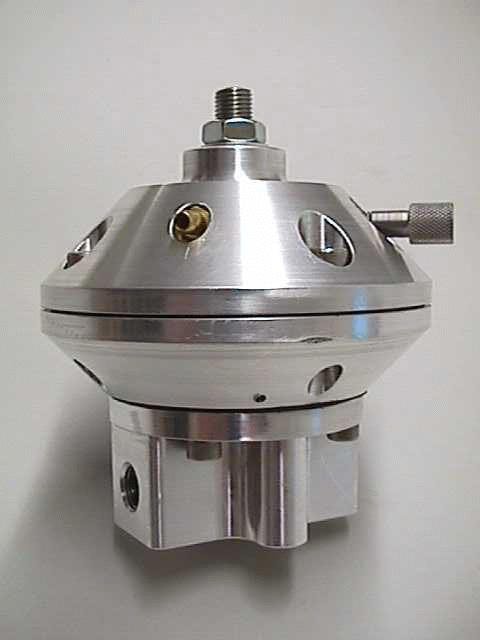Lextreme II
Active Member
I recently uninstalled my Split Second ECU and put back my stock ECU and running SC400 Injectors (251 cc vs. LS400 is 220 cc) along with Walboro fuel pump. I monitor the AFR very carefully and currently running 9 psi without any timing control. The car felt alot better then split second. This is due to ill-tuned piggyback. The car starts nicely along with perfect idle. This unit really solve lots of headaches if you plan to run less then 8 psi.
Its headache free and almost tuning free. I use Cartech FMU
If you are interested reading more about what is FMU. Here it is:

Purpose of the Rising Rate Regulator
The Cartech regulators are designed specifically to add fuel to modified EFI engines (turbos, superchargers and normally aspirated). This is accomplished by using the manifold vac/pressure to drive the fuel pressure up as the boost rises, or with the N/A engines, as the vacuum goes toward atmospheric. If we already build the best FPR’s (often called FMU’s), what’s the sanity of making another? The answer is to keep the copiers way behind. Our original FMU, introduced in 1975, has been copied six times and is still used by four companies. The 2020 series regulator is the fourth generation design to come from Cartech, and every new design has been better than the previous. Imagine how vastly better these new designs are than that 25 year old relic the other guys are still producing!
The broad range of tuning capability by changing fuel pressure has yet to be fully explored. We have pioneered this concept with the introduction of the rising rate fuel pressure regulator. It has been created for the purpose of increasing the fuel flow through electronic fuel injection systems when conditions of engine load demand more fuel. Unique to the rising rate regulator is that the pressure only increases when needed then returns to stock. This concept does not keep the fuel pressure up all the time. The concept of the rising rate regulator is particularly useful in three circumstances:
1. The factory turbo/supercharger car when the stock boost pressure is increased.
2. An aftermarket turbo/supercharger system applied to an EFI equipped car.
3. A normally aspirated EFI car with modifications that increase the air flow.
These regulators are unique with the adjustability of rate of gain as well as onset of gain. The potential for increasing fuel flows is very large, with as much as 40% more fuel available. This solution is particularly attractive as it is less expensive and tunable. The regulator installs in the EFI return line after the stock regulator and overrides the stock regulator at full throttle or when under boost. One truly unique feature of our design is the ability to begin raising the fuel pressure before getting under boost. This ability will tune out the inherent turbo/supercharger lean flat spot at the onset of boost.
(Bracket and fittings included)
Key Benefits
*Billet manufacture
*Anodized surfaces (opt). We offer plain aluminum, red, blue, or black anodizing.
*Improved valving
*Fewer parts with the integrated accessory design
*Increased the span of adjustment for broader rates of gain. Even the onset of gain is adjustable! No other regulator has onset adjustment.
Its headache free and almost tuning free. I use Cartech FMU
If you are interested reading more about what is FMU. Here it is:

Purpose of the Rising Rate Regulator
The Cartech regulators are designed specifically to add fuel to modified EFI engines (turbos, superchargers and normally aspirated). This is accomplished by using the manifold vac/pressure to drive the fuel pressure up as the boost rises, or with the N/A engines, as the vacuum goes toward atmospheric. If we already build the best FPR’s (often called FMU’s), what’s the sanity of making another? The answer is to keep the copiers way behind. Our original FMU, introduced in 1975, has been copied six times and is still used by four companies. The 2020 series regulator is the fourth generation design to come from Cartech, and every new design has been better than the previous. Imagine how vastly better these new designs are than that 25 year old relic the other guys are still producing!
The broad range of tuning capability by changing fuel pressure has yet to be fully explored. We have pioneered this concept with the introduction of the rising rate fuel pressure regulator. It has been created for the purpose of increasing the fuel flow through electronic fuel injection systems when conditions of engine load demand more fuel. Unique to the rising rate regulator is that the pressure only increases when needed then returns to stock. This concept does not keep the fuel pressure up all the time. The concept of the rising rate regulator is particularly useful in three circumstances:
1. The factory turbo/supercharger car when the stock boost pressure is increased.
2. An aftermarket turbo/supercharger system applied to an EFI equipped car.
3. A normally aspirated EFI car with modifications that increase the air flow.
These regulators are unique with the adjustability of rate of gain as well as onset of gain. The potential for increasing fuel flows is very large, with as much as 40% more fuel available. This solution is particularly attractive as it is less expensive and tunable. The regulator installs in the EFI return line after the stock regulator and overrides the stock regulator at full throttle or when under boost. One truly unique feature of our design is the ability to begin raising the fuel pressure before getting under boost. This ability will tune out the inherent turbo/supercharger lean flat spot at the onset of boost.
(Bracket and fittings included)
Key Benefits
*Billet manufacture
*Anodized surfaces (opt). We offer plain aluminum, red, blue, or black anodizing.
*Improved valving
*Fewer parts with the integrated accessory design
*Increased the span of adjustment for broader rates of gain. Even the onset of gain is adjustable! No other regulator has onset adjustment.
